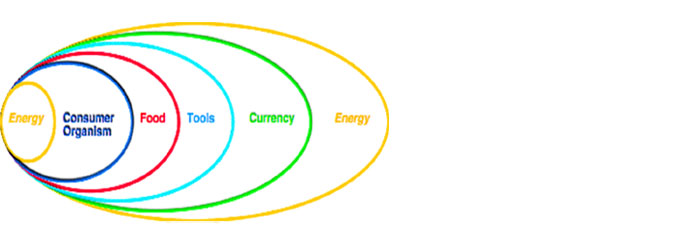"Energy is also measured in joules. In many ways it resembles money: it is a currency in which all processes in nature must be paid for. Just as money can come in dollars, pesos, yen, rubles or liras, so energy can come in many forms--electricity, heat, light, sound, chemical, nuclear. The expression for the total energy of a system of objects can be written
E = (potential) + (kinetic) + (electric) + (heat) + . . .
where "kinetic" for instance stands for the sum of mv2/2 for all the component parts. And it is still true that if the system does not interact with the outside, the total value of E is conserved."
Blueprint for a National Consumer Organism:1) THE GOVERNMENT DECLARES ITS INTENTION TO BECOME A NET ENERGY SUPPLIER (AS OPPOSED TO A NET ENERGY CONSUMER.
2) The government then first declares that it intends to support the value of its currency in terms of energy, such as a given quantity of joules/kilowatts (in lieu of gold or a basket of commodities, etc.)
3) Concurrently –recognizing that both taxes and the cost of energy are sequentially accumulated to produce the final cost of EVERY product and service, the government then announces that it will begin to implement this policy by first establishing what begins, at first, as a closely regulated National Energy Preserve (NEP). The NEP is initially comprised of every entire direct supply chain that eventually results in the final production of some form of renewable energy technology or energy production (i.e. from mining to transportation to final assembly and to the point of purchase)
4) Within every direct supply chain, every form of tax, inclusive of all Local, State and Federal taxes, is then selectively and retroactively eliminated (i.e. from the mining of ores to final product output, etc.) –and specifically, all income taxes—while simultaneously limiting the profit margins (calculable in terms of the Joule Standard) of every entity within the NEP to some predetermined maximum. The total effect of this step is thus an immediate reduction in the final cost of each and every technology involved, and therefore ultimately also the cost of energy production as well.
5) The government then immediately begins to purchase these technologies in terms of its new currency, while simultaneously obtaining the means to support its stated value (the number of joules per krona, dollar, ruble etc.)
6) As the final cost of technologies within the NEP consequently decline --and thus the cost of energy itself-- the potential cost of energy for the industries themselves is also reduced. This of course, compounds the reduction in cost obtained through the elimination of taxes, so the government now has an increasingly cheaper source for energy producing technologies.
7) Since the government is highly motivated to remain a permanent customer, as the cost of energy declines (now measured in terms of energy) declines, the effective value of the currency increases at the same time as the level of employment.
8) A powerful feedback loop (economic continuum) is now begins to be established, within which, the production cost of energy and renewable energy technologies is dramatically reduced (relative to the extreme inefficiency of the traditional capitalism). Moreover, as the energy supply expands, the cost efficiency of production increases, this is synonymous to an expansion in the “money supply,” as well as a continuously declining need for taxes.
9) As an expanding source of energy in its own right, the government thus has two ways to increase its effective revenues: First, by paying the salaries of its own employees in terms of energy (either directly in terms of energy via the power grid, or in term of currency backed by this self-same energy) --but also by selling energy to the private sector. The potential to do either is therefore expanded merely by increasing its potential as a net energy source.
10) Now, in order to further reduce its expenses while simultaneously expanding its ‘monetary’ base, it then selectively begins to expand the elimination of taxes it began within the Energy Preserve, as it simultaneously begins to serve as an inexpensive energy source for industries that provide more traditional goods and services –specifically, all those goods and services that the government also need in order to function.
11) At some point, the amount of energy the government consumes is exceeded by its potential production. From this point on, the same process begins to accelerate throughout the remainder of the economic continuum –a continuum that is now completely premised on the production of renewable energy.
12) In other words, every individual consumer becomes a potential source of “money” (excess energy production.) The cost of production continues to decline at every level –and yet the “value” of the money remains utterly constant. Why? Because it represents the very essence of the “economic” process.
A summary of consequences…
Finally, in stark contrast to the fundamentally parasitic system of fiat currencies, as the Post Paradox Joule Standard economy approaches saturation:
A) The conventional practice of ubiquitous taxation is ultimately eliminated.
B) The concept of a Central Bank is rendered obsolete –being replaced by a widespread, decentralized process of energy production that “funds” itself.
C) The fundamental problem of economic decline is permanently resolved. For instance, the primary source for ‘stagflation’ (high levels of inflation and unemployment as the twin consequences of reduced energy flow) is simply contradicted by the Joule Standard itself. Employment and currency values increase simultaneously for the same reason: i.e. Energy costs decline as the energy supply rises, which amplifies the potentials for human endeavor.
D) In short, while the present system is maintained by an elite corporatocracy dependent on a system of “cheap” labor (encoded as “free” trade), controlled shortages (OPEC, Big Pharma, etc.) and maximized profits in the context of continuously inflated currencies --the Post Paradox Joule Standard automatically re-structures the very logic of the system itself to produce the opposite result: the elimination of poverty.

No comments:
Post a Comment